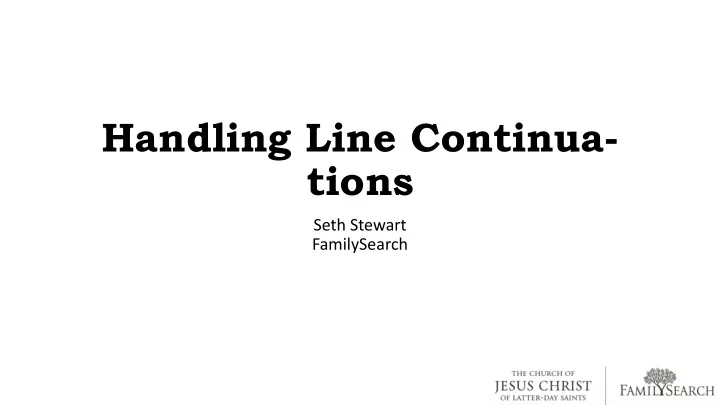

Handling Line Continua- tions Seth Stewart FamilySearch
Language Modeling • Combining knowledge about which sequences are linguistically plausible together with direct feature information • Given input features X and a linguistic probability distribution P, find the maximum likelihood sequence of symbols W*: W* = arg max W p(X|W) P(W) Recognition model Language model • Given an initial transcript, refine it using linguistic knowledge
Dataset: Historical newspaper images American English 1730s-present 344 image crops, ~47.5k words (test set)
Some important cases Example Description Line Text tokens are intended to be distinct continuations Line continuations Ditto above Line-continuations Hyphen forms a compound word consisting of multiple distinct words on the same line Line continua- A word is split across lines, joined by a hyphen tions Line continua A words is split across lines, with no hyphen indicator tions
Statistics Across all word chunks in the training set: • 73% of chunks are "words" according to the dictionary • 1.2% are valid multiline words • 1-6% of multiline words are NOT hyphenated (But maybe some of them should not be joined!) thanksgiving, maybe, beheld, statehouse, druggist, without, detergents, anew, faraway, allover, backaches, percent, tractor, painkiller, schoolteachers, inbound, betaken, generally, eyestrain, cannot These sometimes change the meaning, so join with caution! • Some hyphen-joined multiline words may or may not consume the hyphen: inquest--procure, fitz-william, fellowcountry-men, adjutant-general, re-occupation, seventy-six
Method Training • Concatenate lines of text in training data (with newline marker ↯ ) • Train new language model Inference • concatenate line images (or image features) • inject newline character between line images ↯
Initial Results • 7-8% higher relative word error in initial experiments • Shows potential for correction some multi-line words: nhow ↯ ever Every Dollar Invested in this Com ↞ - ↯ Dpany will whoe ↯ never Some other errors might be addressable through longer-range context
Initial Results Some additional errors were introduced. • Many line-ending punctuation marks disappeared: I never called him any- ↯ thing he was so restless ↞ . ↯ About 2 o'clock • Words at the beginning of a line were un -capitalized: protection from the ↯ Wwild Trapper of the Blue
Take 2: Model Blending • Idea: Use the prevalence of errors to mix and D <space> 0.14771 match line continuations model with the D - 0.079432 original model. D ↞ 0.068954 I <space> 0.047321 • E.g., Don’t preserve space deletions from the D . 0.043265 second model relative to the first model. I ↞ 0.024844 • Result: Better than the first line continuations D e 0.021126 model, but still 2% relative error increase . D s 0.019098 D t 0.017745 • Conclusion: Edit types are not sufficiently D n 0.017069 discriminative to improve the resulting transcript over the baseline
Take 3: Data augmentation • Take ordinary text lines in the training set • Fuse lines using dictionary approach to detect multiline words that should be joined • Inject hyphens and newlines into new random mid-word positions • Result: Same performance as first LC model (+8% WER). Slightly worse blending performance (+2% WER). • This has the unfortunate side effect of bolstering the representation of nearly all of the original sequences in the training set • Using standard discounting & smoothing models, this will degrade our performance on rare strings
Take 3: Data augmentation Continua- tions Continu- ations Con- tinuations Conti- nuations …
Alternative Approaches Improve the context or conditioning by: • Directly augmenting the finite state decoding graph • Recurrent Neural Networks (LSTM, GRU, etc.) • Transformer Networks • Unclear how to integrate into framework – open research problem • Bonus: How to tackle the curse of dimensionality for sequential data?
Thank you! To be contin- ued…
Recommend
More recommend